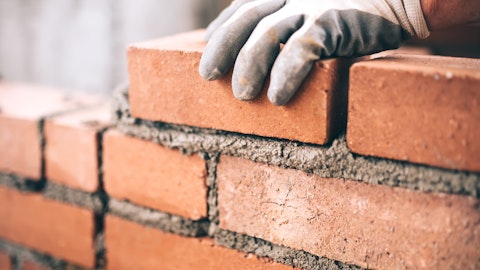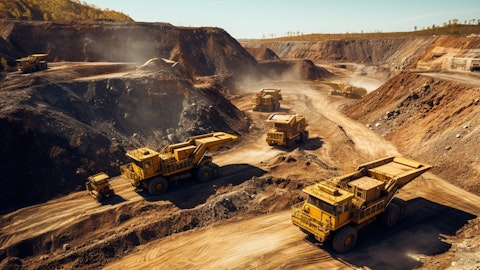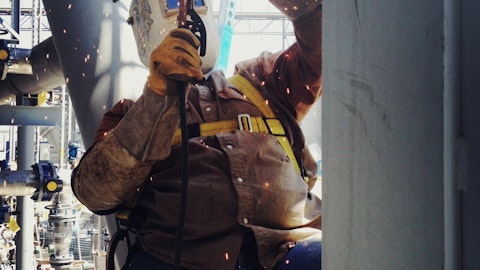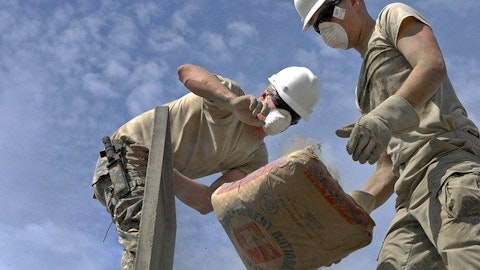Vulcan Materials Company (NYSE:VMC) Q3 2023 Earnings Call Transcript October 26, 2023
Vulcan Materials Company beats earnings expectations. Reported EPS is $2.29, expectations were $2.22.
Operator: Good morning. Welcome, everyone, to the Vulcan Materials Company Third Quarter 2023 Earnings Call. My name is Angela, and I will be your conference call coordinator today. [Operator Instructions] After the company’s prepared remarks, there will be a question-and-answer session. Now, I will turn the call over to your host, Mr. Mark Warren, Vice President of Investor Relations for Vulcan Materials. Mr. Warren, you may begin.
Mark Warren: Thank you, operator, and good morning, everyone. With me today are Tom Hill, Chairman and CEO; and Mary Andrews Carlisle, Senior Vice President and Chief Financial Officer. Today’s call is accompanied by a press release and a supplemental presentation posted to our website, vulcanmaterials.com. Please be reminded that today’s discussion may include forward-looking statements, which are subject to risks and uncertainties. These risks, along with other legal disclaimers, are described in detail in the company’s earnings release and in other filings with the Securities and Exchange Commission. Reconciliations of non-GAAP financial measures are defined and reconciled in our earnings release, our supplemental presentation, and other SEC filings. During the Q&A, we ask that you limit your participation to one question. This will allow us to accommodate as many as possible during the time we have available. And with that, I’ll turn the call over to Tom.

A construction site with heavy equipment and people in hard hats working on the next infrastructure project. Editorial photo for a financial news article. 8k. –ar 16:9
Tom Hill: Thank you, Mark, and thank all of you for joining our call this morning. In September, we officially surpassed our prior goal of $9 per ton cash gross profit on a trailing 12-month basis, and that was before reaching the 230 million tons on a same-store basis and despite macro challenges over the past four years that none of us likely anticipated back in the fall of 2019 when we initially set that target. This accomplishment perfectly demonstrates the durability of our aggregates-led business, and I’m really proud of how our teams continue to execute at a high level. Compounding profitability through the solid execution of our Vulcan Way of Selling and Vulcan Way of Operating Strategic Disciplines is at the core of who we are across our coast-to-coast footprint.
Today, our teams are intensely focused on our new target of $11 to $12 of cash gross profit per ton. Cash gross profit per ton growth is key to increasing our free cash flow and continuing to create value for our shareholders. In the quarter, we generated $602 million of adjusted EBITDA, which is a 19% improvement over the prior year. Our aggregates, asphalt and concrete product lines all posted another quarter of year-over-year gross margin improvement. In the aggregates segment gross margin expanded by 200 basis points and cash gross profit per ton improved by 18% despite lower volumes. Shipments declined 2% in the quarter with variations across end uses and geographies. Residential weakness impacted the majority of our markets, while at the same time many of our markets are seeing improving momentum in highway shipments.
Private non-residential construction activity related to large industrial and manufacturing projects continue to drive healthy volume growth, particularly in Georgia and the Carolinas. Remember, footprint matters in the aggregates business. Ours is unmatched in the Southeast, where private demand dynamics are currently strongest, and across the country in states where IIJA investments will be the most significant. Pricing momentum continued across our footprint, with all geographies achieving healthy year-over-year increases. Average selling prices improved 15% in the quarter and 3% sequentially, more than offsetting continued inflationary cost pressures. In asphalt, gross margin improved 660 basis points. Shipments increased 11% and across most geographies with particular strength in California.
Average selling prices improved 2% and cash unit profitability improved over 50%, benefiting from lower liquid asphalt costs and solid manufacturing cost control. Concrete gross margins improved 120 basis points. Cash unit profitability improved by over 30%, despite lower volume that continued to be impacted by the slowdown in residential construction activity. Remember, prior year concrete segment earnings benefited from the contribution of the now divested New York, New Jersey and Pennsylvania concrete operations. Through the first nine months of the year, we have executed well and successfully navigated evolving macro dynamics. Let me comment briefly on what we are currently seeing in each end use. Starting with residential, we are encouraged by the recent growth in single-family permits and starts in many geographies over the last three months.
On the other hand, after providing some support for overall residential demand, multi-family starts have now begun to pull back from historically high levels. Affordability and higher mortgage rates are likely to continue to have some impact on residential activity, but the underlying fundamentals remain firmly in place. Vulcan markets have low housing inventory levels and favorable demographics, driving the need for additional housing. In private non-residential construction, trends differ across categories. As expected, warehouse activity, the largest non-res category, has softened, but manufacturing activity remains at high levels and is concentrated in Vulcan states. We have booked and are shipping on numerous large manufacturing projects where we offer customers a differentiated solution with our advantaged footprint and logistics capabilities.
On the public side, leading indicators remain supportive of continued growth in both highway and infrastructure. Trailing 12-month highway starts are up 18% and 2024 state budgets are at record levels. We continue to expect accelerating growth in public construction activity into next year and continued growth for the next several years. Our nimble sales and operating teams are well prepared to deliver value for our customers in any demand environment and to continue to improve unit profitability and drive value for our shareholders. Now, I’ll turn the call over to Mary Andrews for some additional commentary on our third quarter performance and upgraded 2023 outlook. Mary Andrews?
Mary Andrews Carlisle: Thanks, Tom, and good morning. Over the last 12 months, we have improved our adjusted EBITDA margin by 220 basis points, posted a 97% free cash flow conversion ratio before our strategic reserve purchases, returned $275 million to shareholders via dividends and repurchases, improved our return on invested capital by 180 basis points, and reduced our net debt to adjusted EBITDA leverage to 1.8 times. Our robust operational performance that Tom highlighted, coupled with our sound capital allocation and strong balance sheet, position us well for continued success on our strategic objectives of further enhancing our core and expanding our reach. As part of our ongoing portfolio optimization, we are currently working to finalize an agreement for the disposition of our Texas concrete assets.
As a result, during the quarter, we classified these assets as held for sale and recorded a $28 million pretax charge to adjust the carrying value to fair value. During the first nine months, we have invested $411 million in maintenance and growth capital. We continue to expect to spend between $600 million and $650 million on maintenance and growth capital and $200 million on strategic reserve purchases for the full year. Year to date, our SAG expenses have increased a modest 3% and improved by 30 basis points as a percentage of revenue. Year-over-year increases are due mostly to higher incentive accruals congruent with improved earnings. Our investments in talent and technology to support our business objectives are paying off in operational results.
After another quarter of strong operational execution and financial results, we now expect to achieve between $1.95 billion and $2 billion of adjusted EBITDA for the full year 2023, a greater than 20% improvement versus the prior year at the midpoint. We plan on carrying this strong momentum into next year. So I’ll now turn the call back over to Tom to provide some initial commentary on 2024 and a few closing remarks.
Tom Hill: Thank you, Mary Andrews. While we are still finalizing our operating plans for 2024, let me offer some early commentary on our expectations, and I’ll start with the two things I’m most confident in regarding 2024. First, aggregates pricing momentum. For the last seven quarters, aggregate prices have exceeded historical norms, and the price environment remains quite positive. Our Vulcan Way of Selling is driving our commercial execution. We expect prices to improve at least high single-digit in 2024. Second, public demand. We are confident in growing public demand, supported by the recent growth in contract award activity and healthy state DOT budgets for 2024. We expect public construction activity to accelerate next year.
Now, there’s more uncertainty regarding the impact of the microeconomic environment on private demand that makes it, frankly, a little bit or too early to call. While current trends in single-family residential activity are positive, uncertainty remains as to how higher rates and affordability challenges may impact that sector overall and influence whether or not it returns to growth next year. In private non-residential demand, similar uncertainties exist as to how a higher rate environment could impact the sector overall. Additionally, if warehouse activity continues to pull back from the recent historical high levels, it may further mask the current strength in manufacturing activity and will be a key driver of the decline – the degree of decline in non-residential demand.
We’ll give you an update in February as to how we see these dynamics unfolding and what that means for aggregate shipments in 2024. I am confident that our teams are well equipped to deliver unit profitability growth in any macro environment, and they have a proven track record of doing so. Over the last 12 months, even in the face of a volatile macro backdrop and lower aggregate shipments, our aggregates cash gross profit per ton has expanded by 18% and our adjusted EBITDA has improved 17%. As we work to finish this year strong and finalize our plans for 2024 over the next couple of months, we remain focused on keeping our people safe, stay committed to our Vulcan Way of Selling and Vulcan Way of Operating Disciplines and continue to deliver value for our shareholders.
And now, Mary Andrews and I will be happy to take your questions.
See also 12 Best Clean Laundry Detergent Brands and 15 Best-Selling Car Brands in the U.S..
Q&A Session
Follow Vulcan Materials Co (NYSE:VMC)
Follow Vulcan Materials Co (NYSE:VMC)
Operator: [Operator Instructions] The first question comes from Trey Grooms with Stephens. Please go ahead.
Trey Grooms: Hi. Good morning, everyone. So Tom, I wanted to kind of follow up on the last bit of your commentary here. And I appreciate some of your high-level comments around demand and the end markets. But could you maybe give us enough color where we could try to triangulate maybe the possibilities, if it is possible to call at this point, of if volume could be in positive territory next year as you kind of look at those three or four end markets and understanding there’s a lot of uncertainty here? But any additional color you could give us around that would be helpful.
Tom Hill: Yes. Trey, good morning. Probably a little early to call specifics. I’d say that footprint is going to matter, and I like ours because of the position in the Southeast, it wouldn’t surprise me if we saw a modest decline next year similar to what we’ve seen this year, but we get there a different way. Some challenges on the private side. Single-family we think has hit bottom and is improving. And I think we can get to growth when looking at the full year for 2024. Multi-family, as you know, will be a headwind. So in non-res, I think we’ve got some – it’s a mixed bag. We’ve got some challenges on the light side and our warehouses. Warehouse starts have gotten a little weaker. The headwinds in light warehouses will be partially offset, I think, by the big industrial projects, which really fit us now.
Now, we’ll – you’ll definitely see growth on the private side, both in highways and non-highway infrastructure, driven by state, local and the big IIJA funding. All that said, to your point, I think I could make a scenario to get flat volume next year, but at this point, I’d probably lead us to a modest decline. But that all that being said, remember that similar to this year, we should still realize really strong earnings growth next year, even if we do have a modest decline in volume.
Trey Grooms: Got it. Okay. Thanks for those thoughts, Tom. I appreciate it. I’ll pass it on.
Tom Hill: You bet.
Operator: The next question comes from Tyler Brown with Raymond James. Please go ahead.
Tom Hill: Morning, Tyler.
Tyler Brown: Hi. Good morning.
Mary Andrews Carlisle: Hi, Tyler.
Tyler Brown: Hi. Good morning. Hi, I know there’s obviously going to be a lot of chatter about volumes, but I kind of want to come back to this idea about unit revenues versus unit costs, because it feels like costs are just remaining stubbornly sticky. Volumes are stubbornly opaque. So despite both of those, though, you guys have expanded unit margins. So can you just talk about your confidence in the durability of expanding those margins into next year, kind of regardless of what the market throws at you? And Mary Andrews, just any thoughts on what unit cost inflation ex-fuel could? Thanks.
Tom Hill: Yes. Let me take – I think I’ll take price first. And you are right, we’ll expand margins, and I think we’ll see another year of really strong unit margin growth even in the face of inflation. And it’s really because we carry really good pricing momentum into 2024. That visibility into healthy public demand growth and you couple that with rising energy prices really sets up a good environment for price. Our conversations with our customers for January price increases, I think, have gone very well. If you look at our backlog prices, I think they are very healthy. And as we look at 2024 prices, I’d expect at least high single digit, but I could also see a path to low double-digit pricing. So at this point, we carry really good – we carry excellent pricing momentum into 2024, and we’ll more than offset inflation and see strong unit margin growth.
Mary Andrews Carlisle: Yes. Tyler, and in terms of cost and evaluating next year, I think it’s probably helpful to think about our recent trends on a trailing 12-month basis. You’ll remember on a year-over-year basis, trailing 12-month, total cost, cash cost to sales, began rising in the first quarter last year. And we saw it ramp considerably that delta for five quarters before peaking in the first quarter of this year. It’s since moderated for the last two quarters modestly. And we expect that trend to continue. We just think it’s going to be gradual. So as we think into next year, I think what that means is higher than historical average cost increases in 2024, possibly even high single digits. But as you started with the pricing momentum that Tom described, we can still deliver attractive gross margin improvement and, definitely, unit profitability improvement next year.
Tyler Brown: Okay. Excellent. Thank you.
Tom Hill: Thank you.
Operator: The next question comes from Garik Shmois with Loop Capital. Please go ahead.
Tom Hill: Hi, Garik.
Garik Shmois: Hi. Good morning. Thanks for having me. I was wondering if you can expand on just that last comment, Tom, with respect to seeing a path to low double-digit pricing next year, recognizing you don’t have a formal guidance just yet and you do expect pricing to be at least high single digits. Is that based on the conversations that you guys are having now with the customers and perhaps better-than-expected discussions? Does it require carryover from any mid-year increases you got this year? Or does it require any additional mid-year pricing next year? Just any additional color on how we get to low double digits in 2024?
Tom Hill: Yes. On price, first of all, I would say that it’s high single digit, low double digit. The January price increases conversations gone very well. And as you pointed out, I think as we’ve seen for the last few years, we’ll have mid-year price increase discussions with our customers. It’s just part of the norm now. We’ll – well, I guess we’ll check back in in February with a little more color on that and have a lot clearer view of it. But again, I think as we look forward, it looks pretty good from a price perspective. On cost, as Mary Andrews said, it’s – the place is just stubborn for us. And where we’ve looked past, had low single digit each year. This year – up until 2022, this year, we’re at low double digit. But as Mary Andrews says, starting to fall off, but it’s – I think it’s slower than maybe I would have expected six months ago.
Garik Shmois: Got it. Okay. Thanks for that.
Operator: The next question comes from Anthony Pettinari from Citigroup. Please go ahead.
Tom Hill: Hi, Anthony.
Mary Andrews Carlisle: Morning, Anthony.
Anthony Pettinari: Hi. Good morning. Tom, on private non-residential, you talked about some of these large manufacturing projects in the Southeast helping to offset weakness in some of the lighter categories. And I’m just wondering, as you look over the past few months and as we think about ’24, have you seen any kind of incremental slowdown or delays in some of these megaprojects? Or are they coming kind of on time or maybe faster than expected? I guess, we’ve seen some new stories about maybe availability of skilled labor and contractors in some cases impacting individual projects. But I don’t know if that was something that was widespread or something that you’re seeing with your customer set.
Tom Hill: Actually, I think just the opposite. We’ve seen them come on strong. At this point, I think we booked 11 of those very large projects and starting to ship those. It’ll be more of a 2024 play. Those 11 that I’m thinking of make up about 12 million tons. As we look out, I think we are – probably over the next year, we’ll bid another six, seven, eight of these big projects that would constitute another 14 million tons. So the large industrials are going to move the needle for us in 2024. Geography really helps here. There’s Georgia, Tennessee, Alabama, Mississippi, where a lot of those are right in our footprint. So our geography has really helped us here. But from our perspective, they’ve gone probably a little faster than maybe we have anticipated. So – but remember, we are first coming out of the ground, so supply chain probably impacts us less than maybe others does.
Anthony Pettinari: Okay. That’s very helpful. I’ll turn it over.
Tom Hill: Thank you.
Operator: The next question comes from Stanley Elliott with Stifel. Please go ahead.
Tom Hill: Hi, Stanley.




